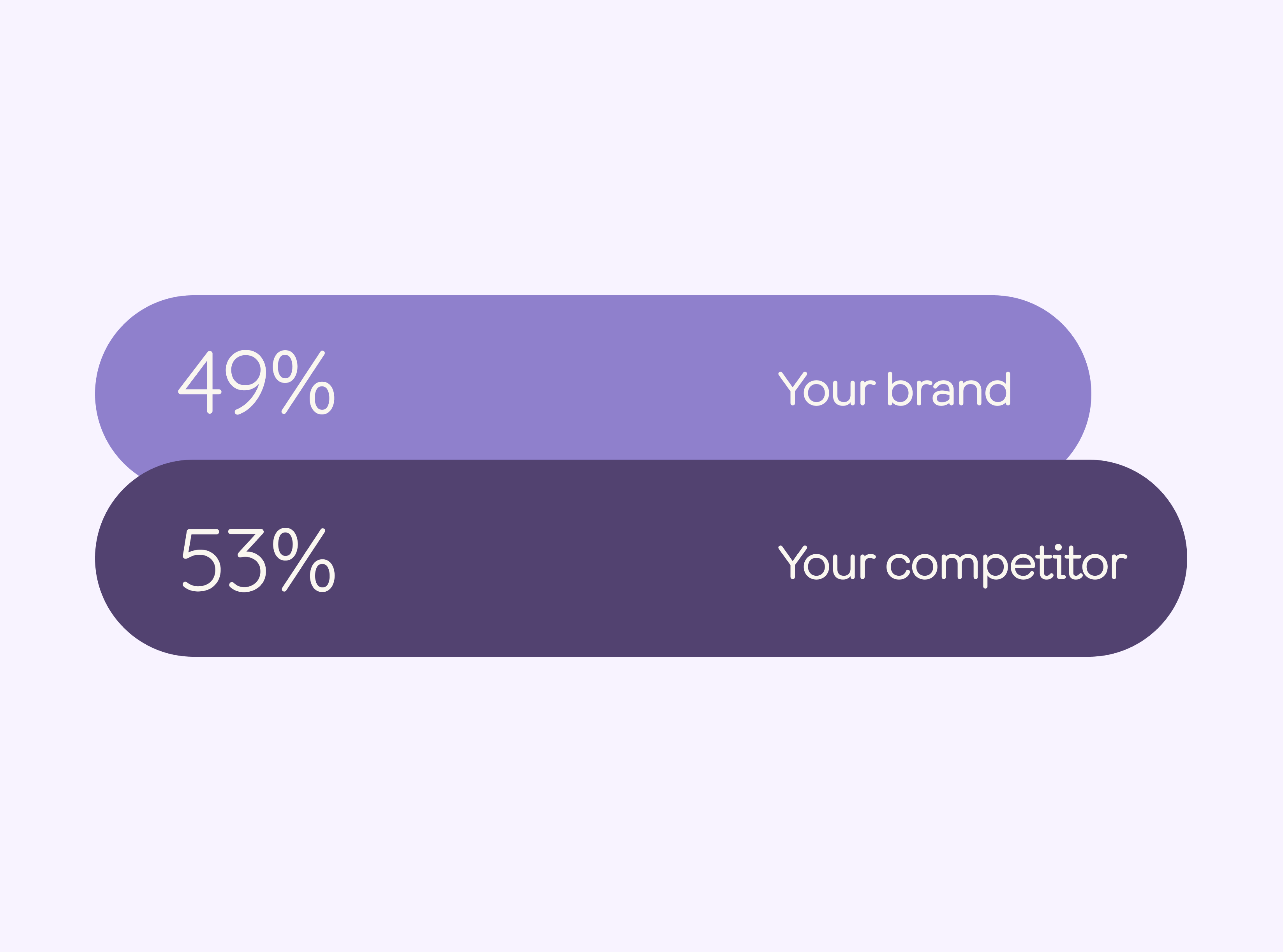Brand audit guide: How to assess the performance of your brand

It’s easy to assume that building a great brand is all about "getting it right" from the very beginning. But even the best brand planning doesn’t guarantee smooth sailing.
Why? Because no business thrives in the long term by setting its brand in stone. Success comes from being innovative and adapting to an ever-changing consumer landscape. So, how do you know what steps are required to keep your brand relevant?
This is where regular brand audits are essential to ensure your brand strategy stays fresh and relevant to your target audience.
Sign up to Shorts
For fortnightly brand insights, stories and goodness that'll help you win (we promise).
What is a brand audit?
A brand audit is a detailed analysis of your brand to assess its overall position in the marketplace. What’s included within a brand review will vary depending on your goals, but will usually focus on:
- Brand health
- Target audience
- Visual assets
- Brand marketing initiatives
- Brand awareness and consideration
- Competitor analysis
- Brand positioning.
Put simply, a brand audit is a way of measuring the strengths and weaknesses of your brand.
Why do you need to conduct a brand audit?
As an annual best practice habit
Cars need a Warrant of Fitness to make sure they’re still in good nick. Why should your brand be any different? A yearly check-up on how your brand is performing is a good idea to make sure that your brand-building efforts stay aligned with your key brand values.
To review your marketing efforts
Successful brand marketing means assessing whether your campaigns are achieving their objectives. But it can be tricky to measure those less tangible KPIs. Of course, we’re talking about that notoriously exclusive metric: Brand awareness
So, how do we measure the unmeasurable? A full brand assessment that explores whether your brand is meeting consumer expectations.
Being able to see whether consumers are moving from brand awareness to consideration is key to understanding whether your marketing efforts are bearing fruit, or whether you need a change of tactics.
To benchmark yourself against the competition
The competitive landscape is never static. The shifting sands of new product launches, rebrands, and marketing campaigns mean that your brand’s position is always in flux.
Unless you’re measuring these fluctuations in the marketplace, it’s difficult to assess your brand’s success relative to competitors. Frequent brand reviews allow you to stay on the pulse of what your rivals are up to.
To assess if your brand strategy is resonating with target customers
To turn awareness into purchases, you need to attract the right target audience.
For example, if you’re trying to attract a more affluent consumer, this won’t work if your brand marketing causes people to see your business as the low-value option. Take an item like bottled water: You’ll have a tough time persuading Essentia devotees that Evian is exactly the same product, thanks to the millions the brand has poured into influencer marketing, opens in new tab
However, you can only take action on these insights if your brand knows how your target customer ticks – hence the need for ongoing brand analysis.
When is the best time to do a brand audit?

You're thinking of doing a rebrand
The decision to rebrand shouldn’t be taken lightly, as brand familiarity is a valuable commodity. But if you’re going to follow through, make sure you understand how your current brand is missing the mark with your target market. A brand audit will help you to identify where a rebrand could help with repositioning and brand perception.
You're a start-up that's grown quickly before fully fleshing out your brand strategy
As a start-up, it’s normal for workflows to be a little ad-hoc when it comes to branding and marketing. But once you've hit your stride, it’s important to lay the foundations for your brand guidelines.
Brand guidelines are your north star and should lay out the standards for everything your brand puts its name to. By conducting a thorough brand analysis, you can codify this valuable time you’ve spent figuring out what works (and what doesn’t).
You want to assess the overall performance of your brand (which you should do at least once a year)
You can’t make any informed decisions about product launches or marketing strategies unless you have a sound understanding of how your brand is performing. Frequent brand audits help you to sell the next stage of your brand’s expansion. Don’t forget: You’re unlikely to get the blessing of the decision-makers upstairs unless you have data to back up your pitch.
Tools like our brand-new Marketing Budget Calculator are invaluable in taking the results of your brand audit and turning them into tangible next steps. We built this calculator to help you determine how much of your budget should go towards brand-building versus short-term sales goals, setting the stage for bigger, better brand marketing.
How to do a brand audit
1. Assess your strategic objectives, business mission, and marketing plan and whether it still feels aligned
For a successful brand review, you need to return to your roots. What pain point or gap in the market is your brand aiming to address, and why? And most importantly: Is your marketing and branding strategy still driving this forward?
It’s easy to scoff ‘of course!’ But your marketing efforts can drift away from your core message over time – especially if you haven’t done regular brand audits.
Pepi’s notorious 2017 T.V. commercial, opens in new tab that tried (and failed) to incorporate social justice is a classic example of the blowback that brands can receive by backing issues they have no history of engaging with. If anything in your review strikes you as ‘off-brand’ – there’s a good chance it probably is.
2. Review digital and social analytics
With more consumers turning to social media and Google Search to compare purchasing options, businesses have a virtual goldmine of data at their fingertips.
Social media analytics can tell you whether your content is being shown to the right demographic and whether it’s driving people to your website in search of further information. Website data is invaluable in a brand audit template to monitor your bounce rates and traffic sources. If your bounce rate is increasing, this could be a sign that your website isn’t giving visitors a cohesive brand experience.
An important metric to consider across all digital channels are your impression counts. Sure, impressions don’t always lead to action (such as clicks and purchases), but they can be a great preliminary indicator of brand awareness.
Someone who has seen your content, ad or website show up on their screen, may not take any further action worth recording right now – deceptively leading some marketers to think their content isn’t effective – but people who see your brand might mentally shelve your name away for later, when they’re ready to buy. You can see why brand marketers often have to fight so hard to prove its value, when there can be a time lag between first brand encounter and results, such as described above!
3. Review sales data
A weekly or monthly review of conversions is an important piece of your brand audit. Sales data adds valuable context to brand marketing and helps to identify where your efforts are having an impact.
If your business experienced a sustained increase in sales after a successful awareness campaign, this is a sign that your brand is resonating with consumers. But if a rebrand or repositioning effort results in a drop-off in sales, this needs to be reviewed.
4. Reach out to customers and survey them
Brand perception is all in the eye of the beholder. This means your brand might not represent everything you think it does to customers.
A thorough qualitative and quantitative review of the customer experience allows you to see where current perceptions might not be aligned with your intended brand image.
5. Reach out to people who could be customers and survey them
Surveying prospective customers matters just as much as your actual customers. Why? Because your target market is the source of valuable insights about brand awareness and consideration. Would-be customers can help you to build future demand (i.e. the key to sustainable growth) by answering questions such as:
- Have you heard about our brand?
- How did you hear about us?
- What values do you associate with our brand?
- Have you ever considered purchasing from our brand? Why/why not?
6. Use brand tracking software to analyze your overall brand performance (and that of your competitors)
Brand health is a tricky thing to measure, especially when low-hanging fruit (like performance marketing metrics) are within tempting reach.
Advanced brand benchmarking in the form of metrics like brand awareness, consideration, and preference allows you to map your progress and understand where your brand marketing efforts have been successful. An intelligent brand tracking software like Tracksuit surveys consumers in your target audience on your behalf, so you can understand how well your brand is building future demand.
7. Review your competitors’ brand strengths and weaknesses
Brands like to think of themselves as having a point of difference over their competitors. On the flip side, there are likely to be areas where competing brands have the upper hand.
Competitors’ SEO performance, social media engagement, content marketing, and customer reviews are all key points of interest you should be investigating in your brand audit.
Competitor analysis reporting, offered as part of our brand tracking dashboard, allows you to benchmark your performance by monitoring how consumers in your target market feel about your competitors as well as your brand.
8. Review results, adjust your strategy, and monitor your progress
Now you've gathered these insights from your brand audit, it’s time to examine where your brand is performing well – where you need to re-focus your efforts. Use these learnings to put together an action plan for how your team can refine your brand strategy.
Each objective should be given a clear timeline and targets to measure results and identify where you may need to make adjustments. Brand audits should be repeated at regular intervals to ensure that your brand is fresh and stays on the pulse of what your customers want.
Brand audit example: Uber

After an unsuccessful 2016 rebrand and growing scrutiny about its corporate culture, Uber realized it needed a better understanding of what its audience wanted.
Based on an in-depth brand audit that involved over 1000 hours spent analyzing customer feedback, Uber decided to go back to basics by focusing on what made the startup successful; making experiences from travel to food delivery accessible to all.
To this end, Uber did away with the confusing ‘bit’ logo introduced in 2016 and focused on the wordmark itself, opting for a less aggressive version in lowercase text. They pivoted to more friendly, people-centered imagery and messaging, helping Uber to shake off the shadow left by its controversial CEO and move into a new era.
Brand audits do take time and effort to carry out. But businesses require regular brand reviews to understand how it’s performing and which areas require adjustment. As the landscape continues to evolve, audits ensure that your brand stays relevant to your target audience and keeps building equity.
The finishing line 🏁
Thanks to Tracksuit’s intelligent, all-in-one brand health dashboard, the start of your next brand audit is a few steps away. Our accessible brand health metrics, based on real-time insights from your target audience, make it easy to see brand activity and impact.
Good luck with your auditing!



